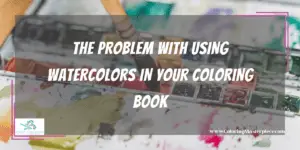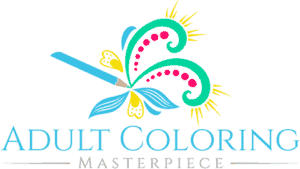The beauty of watercolors is not lost on anyone, and it can be hard to resist their soft, blendable features. Using watercolors in your coloring book might seem like dream material, but this is something you can do with just a few extra steps.
This method can be used with other wet mediums, but it is especially popular for fulfilling a collective desire to use watercolors in coloring books. Read on to learn just how easy it is to use watercolors in your coloring book and reach that perfect finish.
The Problem With Using Watercolors in Your Coloring Book

The biggest issue with using watercolors in your coloring book is that the liquid bleeds through the paper and compromises its structure. When this happens with markers the bigger issue is pigment bleeding onto other pages. The problem can be more devastating with watercolors because you can damage more pages without knowing it.
This is why it is important to prepare the paper properly if you are using watercolors in your coloring book. Not only are you setting a great foundation for the page you are working on, but you are preserving the other pages for future use.
What You Need to Use Watercolors in Your Coloring Book
You do not need to use watercolors in your coloring book. You probably already have most of these items, but each is important for preparing your work surface.
Gesso
This is the key to preserving your coloring book. Gesso primes the surface, giving the medium something to grip and soak into. It is more commonly used for acrylic paint, but it accomplishes the same basic goal here. Gesso comes in a variety of finishes and grits. If you want something that does little to impact the image look for clear gesso with fine grit. Otherwise, choosing a different color or a heavier grit can provide some interesting results. Because gesso can get expensive you want to choose something tried-and-true to start. The gesso put out by Liquitex has been used by many for this exact purpose, and it has no problem getting the job done.
Painter’s Tape
Choose painter’s tape that is strong enough to block gesso from bleeding through but still has a low tack. This combination of features will make it easier to tape off your page without getting stuck in the future.
Wax Paper
Wax paper is the cheapest option for laying under the page to prevent bleed-through, but you can use whatever waterproof items you already have on hand, like:
- Plastic sheet protectors
- Plastic folders
- Placemats
The key is to choose something impermeable; it cannot simply soak up the extra.
Something to Spread Gesso
You do not need something fancy to spread the gesso across the page. If you want to dedicate a tool to this task then a simple plastic palette knife will do. Otherwise, you can use whatever you already have, including old plastic cards or old paintbrushes. You can even use your hands, but make sure you are wearing gloves. Test out different spreading tools before committing to a specific one. There is no right or wrong one; pick what works best for you.
How to Prepare Your Coloring Book for Watercolors
The road to using watercolors in your coloring book begins with preparing your coloring book page for their presence. If you are using wax paper you start by cutting it down to a size that is larger than your page. This does not need to be extremely large. This goes underneath the page you are coloring. Use the painter’s tape to secure the page to the wax paper on all four sides. Make sure you do not forget the edge of the paper that is at the binding; if water gets into the center of the book it can affect most of the other pages.
Once you have secured the page to the impermeable layer beneath it you can continue to put a thin layer of gesso on top. Start small; gesso adds up quickly. Make sure it covers the surface as evenly as you can get it. Most prefer to use two layers of gesso. This reduces the chance that there are any untouched spots, and it is not so thick that it warps the paper. You do need to wait until the gesso is completely dry to start coloring on it, usually overnight.
What about an alternative to watercolors? Learn about watercolor brush pens!
How to Use Watercolor Paint in Your Coloring Book
When using watercolor paint in your coloring book you should still work to conserve the liquid you get on the page. Puddles are a big no; instead, you want to see a light sheen. Drop colors on the area instead of putting the brush on the paper. Keep a paper towel or cloth at hand to soak up any extra water from a brush that might be too wet. The key is to use as little water as possible while still achieving the effortless, otherworldly blend.
Recommended Watercolor Paint Sets
You can use whichever watercolors you are most comfortable with. If you are looking for a set to use specifically with coloring books you should consider a travel set. This helps you keep a variety of colors on hand without taking up much space. If you want something a bit more stylish to carry around consider this 48-color set by Artistro. It includes a wide range of colors and comes in a beautiful locking metal case that slips right into your bag.
Look for sets that pack a punch when it comes to pigment, such as Arteza’s watercolor set. Cheaper sets will need you to put more pigments down. This means more water on the page, and it increases the opportunity for warping. Even with a protective gesso layer, using too much water can break down the fibers of the page. This can be addressed by using a cloth to remove water from the page, but once it soaks in there is no way to reverse the damage done.
How to Use Watercolor Pencils in Your Coloring Book
If you are not familiar with using watercolor pencils, these are just water-soluble colored pencils that you can use in pretty much the same way as regular colored pencils. When working with watercolor pencils you do not need to color as thoroughly, and you might need to be more mindful of your pencil strokes. These are both due to what happens when you add water to the marks on the page. Watercolor pencils can be “activated” by water, making it easier for you to blend and move the pigments around on the page. This works great if you want more control over color placement.
When activating your watercolor pencils you still want to use water sparingly. To compensate for this you can use more colored pencils than you would normally to give a smaller amount of water more pigment to play with. It might take a bit of work to find a good pencil-to-water balance, but it is well worth testing out.
Recommended Watercolor Pencils

You can be less picky with watercolor pencil brands because you have greater control over the amount of pigment put on the page, but you still need to choose something that dissolves easily. Avoid brands that require a lot of water to activate. Derwent Watercolour Pencils are a high-quality option that responds well to water. They come in counts of 12, 24, 36, 48, and 72, so it is not difficult to find a palette to match your needs.
Their Inktense pencils are also water-soluble, but you must distinguish that these are not watercolor pencils but acrylic ink. This means that once they dry the image is set. With watercolor pencils, you can add water to continue to manipulate the pigment, but that cannot be achieved with Inktense pencils. If you need more pigment from your pencils the Faber Castell Albrecht Durer Watercolor pencils come highly recommended. One of the best things about these pencils is that their color remains consistent once they are activated, something that can be infuriating with some cheaper brands.
Fun Experiments with Watercolor in Your Coloring Book
Using Different Colored Gesso
Gesso usually comes in clear or white varieties, but you can find it in different colors, including:
- Gray
- Black
- Red
- Gold
- Umber
These are only a few, but it is easier to find gesso in neutral colors. Using colored gesso instead of clear gives you an interesting base to work within your image. You might even consider using different colored gesso in different areas to create variety on your coloring page.
Using Different Textures
Using different gesso textures can provide interesting results as well. Usually, you just want to wash over the page with a fine gesso to prevent adding texture, but the grittiness can be fun to play with at times. Choosing a gesso with a medium or coarse texture gives you something new to work with, and it can create depth in an otherwise two-dimensional piece. Using a fine gesso for the background and a coarser gesso for subjects can make them pop.
Mixed Media with Watercolors
While you are already preparing the surface for wet media consider using other materials that might be difficult to utilize in a coloring book, such as other paints or markers. These are some bolder options that do not get much chance to shine in a coloring book. Just keep in mind that the texture of the page after using gesso is likely to tear up your markers, so work with caution.
Maximize the benefits of coloring with my free adult coloring eBook and by signing up for my email newsletter HERE!
Disclaimer: The information provided by ColoringMasterpiece.com (“The Site”) is for general informational purposes only. All information on the Site is provided in good faith, however, we make no representation or warranty of any kind, express or implied, regarding the accuracy, adequacy, validity, reliability, availability, or completeness of any information on the Site. Under no circumstance shall we have any liability to you for any loss or damage of any kind incurred as a result of the use of the Site or Reliance on any information provided on the Site. Your use of the Site and your reliance on any information on the Site is solely at your own risk. This blog post is for educational purposes only and does not constitute legal advice. Please consult a legal expert to address your specific needs.
Terms and Conditions: https://coloringmasterpiece.com/terms-and-conditions/
